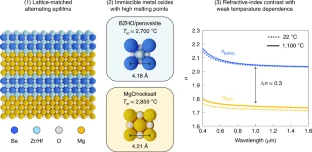Nanowerk September 22, 2022
A team of researchers in the US (University of Michigan, University of Virginia) has developed materials using destructive interference phenomenon to reflect infrared energy while letting shorter wavelengths pass through. Using pulsed laser, they deposited oxides of calcium and titanium oxides. Oxides made the material more durable, less likely to degrade at high temperature, and they could be more precisely layered. The material controlled the flow of infrared radiation and was stable at temperatures of 2,000 degrees Fahrenheit in air, a nearly twofold improvement over existing approaches. After testing they confirmed that the material worked as designed. They used computer modeling to identify hundreds of other combinations of materials that are also likely to work. While commercial implementation of the material tested in the study is likely years away, the core discovery opens a new line of research into a variety of other nanophotonic materials that could help future researchers develop a range of new materials for a variety of applications. This could potentially reduce heat waste in thermophotovoltaic cells…read more. TECHNICAL ARTICLE

Design criteria for ultrahigh-temperature-stable and optically tunable BZHO/MgO photonic crystals… Credit: Nature Nanotechnology, 22 September 2022